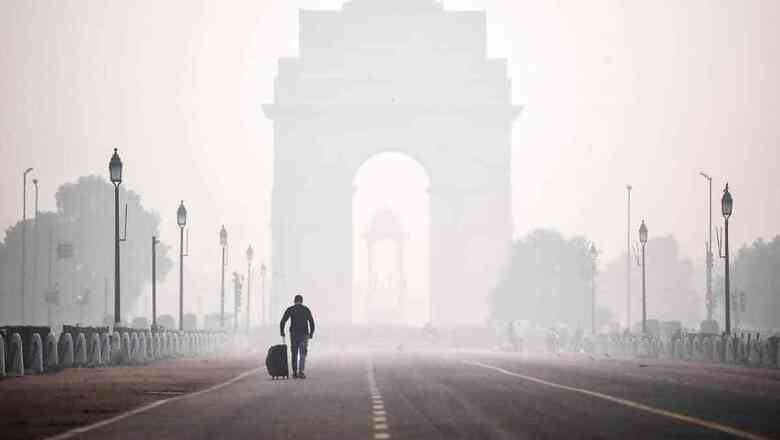
views
A four-year high of farm fires in Punjab, local pollution and adverse weather conditions once again caused Delhi-NCR to breathe toxic air in the early months of winter.
PM 2.5 levels before Diwali were 12-15 times above safe limit on a few days. However, those living in Delhi-NCR also breathed high levels of ultrafine PM 1 particles mid-October to mid-November, an interim analysis done as part of an ongoing NASA-funded study on pollution in north India and Indo-Gangetic plains revealed.
Over the period of a month between mid-October to mid-November, PM 1 levels remained high in the range of 200-300 micrograms/cubic metre (ug/m3), said a team of scientists, professors and researchers from Indian Institute of Delhi, Jawaharlal Nehru University and Delhi University. This data was based on 40 low-cost sensors.
The analysis of PM 1 particles is important as no government agency monitors concentration of these ultrafine particles on a continuous basis, like they monitor PM 2.5 and PM 10 pollution. In fact, there are neither international standards nor domestic standards that define the prescribed or safe limits of PM 1 concentration. The World Health Organization (WHO) has annual mean air quality standards for PM 2.5 and PM 10, but none for PM 1.
These ultrafine particles are deadlier than fine PM 2.5 particles (which are of 2.5 microns in diameter or lesser) as they penetrate the mucus membrane of the lungs and enter into bloodstream. Once they enter the bloodstream, these particles can cause myriad health complications and diseases. Depending on the chemical nature of the particle, it can precipitate acute inflammatory reaction and in persons with a compromised heart function it can cause myocardial infarction, the analysis stated.
“Main focus of air pollution narrative is on PM2.5 but the particles of size 1.0 micron or less in diameter are more harmful, as they can cross the mucus barrier and through blood circulation can reach any organ and cause damages or increase the risk of cancer,” said Dr Arun Sharma, Professor – Director, Community Medicine, University College of Medical Sciences, Delhi University.
Prolonged exposure to PM 1 containing Volatile Organic Compounds (VoCs) or polycyclic aromatic hydrocarbons (PAH) can be carcinogenic and teratogenic as well, the analysis said, citing published studies.
As per the State of Global Air Report, 2020 long-term exposure to outdoor and household air pollution contributed to 16,67,000 deaths in India, in 2019, from stroke, heart attack, diabetes, lung cancer, chronic lung diseases and neonatal diseases. The report also said that in the last decade, 3.73 lakh deaths were linked to exposure to high levels of PM 2.5.
As part of this ongoing study, the team of researchers and scientists is monitoring pollution across Punjab, Haryana, Delhi-NCR, Uttar Pradesh, Bihar and Jharkhand using independent, low-cost sensors. Validating satellite data on pollution is also one of the objectives of this study, researchers associated with the project said.
“Eventually, 100 such sensors will be in use. It is important to measure PM 1 contain heavy metals and they can easily penetrate into our respiratory organs. Dust, vehicular pollution are some of the sources of this pollution. If there is high concentration of PM 1, it also helps in formation of bigger particles when weather conditions are unfavourable,” said Palak Balyan, post-doctoral fellow, Centre for Atmospheric Sciences, IIT-Delhi.
Meteorology and PM 1 particles
Higher concentrations of PM 1 are also a problem as they lead to formation of bigger particulate pollution and secondary pollutants owing to complex atmospheric processes. Meteorological factors play a crucial role in aggravating particulate pollution, due to the combination of solar radiation, moisture levels and calm winds, said Professor Surendra Dhaka, Associate Professor, Department of Physics, Rajdhani College.
Professor Dhaka said that early hours of the morning show high concentration of pollutants and a spike happens due to the phenomenon of uplifting, which happens after sunrise. “With evaporation, there is uplifting of fine particles from leaves and the earth. During this process, smaller particles begin to merge to transform into bigger particles in the range of PM 2.5 and above,” said Professor Dhaka.
The team’s analysis showed that PM 2.5 concentration went from 250-500 ug/m3 in last week of October to above 1,000 ug/m3 prior to Diwali. “In the early hours, there is abundance of submicron particles and it provides a favourable condition for merging of small particles due to moisture and low temperatures,” Professor Dhaka added.
Read all the Latest News, Breaking News and Coronavirus News here



















Comments
0 comment